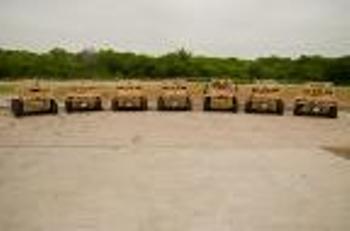The Squad Mission Support System (SMSS) from Lockheed Martin would be deployed for the first time in Afghanistan by the U.S Army.
 LOCKHEED MARTIN SMSS Lockheed Martin's Squad Mission Support System (SMSS) vehicles can carry more than half a ton of a squad's equipment.
LOCKHEED MARTIN SMSS Lockheed Martin's Squad Mission Support System (SMSS) vehicles can carry more than half a ton of a squad's equipment.
The SMSS had won the Project Workhorse Unmanned Ground Vehicle competition which was sponsored by the Army. The deployment would be done by the U.S Army Rapid Equipping Force through their Robotics Technology Consortium.
The SMSS would be the largest autonomous vehicle that was ever deployed by the infantry, it measures 11 feet in length and is capable of carrying more than half a ton of equipment. The load carrying capacity of the SMSS benefits the soldier by reducing his burden. Scott Greene, the vice president of ground vehicles at Lockheed, mentioned that the SMSS is the fruit of robotic developments spanning more than a decade. He pointed out that it has cleared three domestic user tests conducted by the army and has been declared as ready for deployment.
Initially, four vehicles and a field service representative would be working to support the infantry as part of the Military Utility Assessment (MUA). During this time the army would evaluate how effectively the autonomous vehicles are supporting their operations and how much of burden is reduced for soldiers. Apart from the four vehicles, a fifth vehicle and the representative would also be present and would be detained in US as additional support. The Army plans to start the Afghanistan deployment during the latter half of this year, after all the evaluations have been completed. Greene explained that the next step would be an in-theater assessment for gathering future requirements for squad-sized UGV developments. The CH-47 and the CH-53 helicopters are capable of transporting a fully-loaded SMSS. The SMSS Block I variant comes with three control alternatives, namely, tele-operation supervised autonomy and manual driving. The range of the variant is 125 miles. The sensor set up allows the vehicle to lock on and track any person by matching their digital 3-D profile. This profile is captured by the sensors present on board. With the help of GPS waypoints it is able to navigate terrain independently. Further to the MUA at Fort Benning, the SMSS would be evaluated by the Army’s Expeditionary Warrior Experiment (AEWE) Spiral G in November 2011. This evaluation would assess the surveillance, target acquisition and reconnaissance ability of the SMSS.